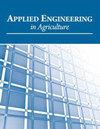Soil Rut Effects on Planter Performance for Cotton in a Conservation Tillage System
IF 0.8
4区 农林科学
Q4 AGRICULTURAL ENGINEERING
引用次数: 0
Abstract
Highlights Soil rutting commonly occurs during harvest and these ruts can adversely affect row crop planter performance. Four rut types were used, two formed by a tire and two formed by cutting the soil and removing soil from the ruts. Cotton seedling emergence at 15 days after planting typically was greater in unrutted soil than in rutted soil. Regression equations show a trend of decreased emergence as rut depth increased for both a sandy loam and a clay soil. Abstract. Soil rutting commonly occurs during harvest and ruts formed during harvesting can adversely affect row crop planter performance at the start of the subsequent cropping season. We conducted a three-year experiment on a sandy loam and a clay soil to investigate effects of soil ruts on the performance of a row crop planter while planting cotton into a rolled rye cover crop, and effects of planter depth setting on planter performance when planting through soil ruts. The four rut types used, prior to planting the rye cover crop in the fall, were a single tire rut, the rut from a dual pair of tires, and two rut types formed by cutting the soil 25 and 50 mm (1 and 2 in.) deep and removing soil from the ruts. The results show that although not all differences were statistically significant, for five of the six combinations of year and soil, cotton seedling emergence at 15 days after planting was greater when the soil had no rut, i.e., flat unrutted soil, than when the planter traveled across soil ruts while planting. In four of the six combinations of year and soil, emergence was significantly greater for the no rut soil condition than for a rut which was formed the previous fall by cutting 50 mm (2 in.) deep and removing soil from the rut. The three seeding depth settings used in the experiment positioned the bottom peripheries of the two disks of the double-disk opener 28, 35, and 40 mm (1.1, 1.4, and 1.6 in.) beneath the bottom peripheries of the depth-gauge wheels, providing those nominal seeding depths before the closing wheels firmed the soil. The planter depth setting did not significantly affect emergence at 15 days after planting for any of the six combinations of year and soil. Mean values of emergence at 15 days after planting in the sandy loam, averaged over the three years, were 13.9, 11.5, 12.2, 11.4, and 7.6 plants/m of row length (4.2, 3.5, 3.7, 3.5, and 2.3 plants/ft of row length) for the No rut, Single tire, Dual tire, Shallow cut, and Deep cut conditions, respectively. The means in the clay were 13.6, 5.7, 5.8, 12.6, and 7.4 plants/m of row length (4.2, 1.7, 1.8, 3.8, and 2.3 plants/ft of row length), respectively. Regression equations show a trend of decreased emergence as rut depth increased for both soils, with the clay regression line having a greater magnitude slope than the sandy loam line. Keywords: Cotton, Emergence, Planters, Planting, Seeders, Seeding, Soil ruts, Sowing.保护性耕作制度下土壤车辙对棉花种植性能的影响
土壤车辙通常发生在收获期间,这些车辙会对行栽作物的种植性能产生不利影响。使用了四种车辙类型,两种是由轮胎形成的,两种是通过切割土壤和从车辙上去除土壤形成的。棉花幼苗在播种后15天出苗率在未污染土壤中明显高于在有车辙的土壤中。回归方程表明,随着车辙深度的增加,砂壤土和粘土的出苗率均呈下降趋势。摘要土壤车辙通常发生在收获期间,收获期间形成的车辙会在随后的种植季节开始时对行播作物的种植性能产生不利影响。在砂质壤土和粘土上进行了为期3年的试验,研究了黑麦套种棉花时土壤辙痕对行栽机生产性能的影响,以及通过土壤辙痕种植时播种机深度设置对播种机生产性能的影响。在秋季种植黑麦覆盖作物之前,使用的四种车辙类型是单一的轮胎车辙,双对轮胎的车辙,以及通过切割土壤25和50毫米(1和2英寸)深并从车辙中去除土壤而形成的两种车辙类型。结果表明,虽然并非所有差异都具有统计学意义,但在6个年份和土壤组合中,有5个年份和土壤组合在种植后15天的棉花出苗率在土壤无车辙(即平坦无垢土壤)的情况下高于种植时穿越土壤车辙的情况。在6个年份和土壤组合中的4个中,无车辙土壤条件下的出苗率显著高于在前一个秋天通过切割50毫米(2英寸)深并从车辙中去除土壤而形成的车辙。实验中使用的三种播种深度设置分别将双盘开启器的两个圆盘的底部边缘定位在深度测量轮底部边缘以下28、35和40 mm(1.1、1.4和1.6英寸)处,在闭合轮固定土壤之前提供这些标称播种深度。在6种年份和土壤组合中,种植深度设置对种植后15天出苗均无显著影响。无车胎、单胎、双胎、浅切口和深切口条件下,播种后15 d出苗率的3年平均值分别为13.9、11.5、12.2、11.4和7.6株/m(行长4.2、3.5、3.7、3.5和2.3株/ft)。粘土中的平均值分别为13.6、5.7、5.8、12.6和7.4株/m(行长4.2、1.7、1.8、3.8和2.3株/ft)。回归方程表明,随着车辙深度的增加,两种土壤的出苗率均呈下降趋势,粘土回归线的坡度大于砂壤土回归线。关键词:棉花,出苗,播种机,种植,播种机,播种,土结,播种
本文章由计算机程序翻译,如有差异,请以英文原文为准。
求助全文
约1分钟内获得全文
求助全文
来源期刊

Applied Engineering in Agriculture
农林科学-农业工程
CiteScore
1.80
自引率
11.10%
发文量
69
审稿时长
6 months
期刊介绍:
This peer-reviewed journal publishes applications of engineering and technology research that address agricultural, food, and biological systems problems. Submissions must include results of practical experiences, tests, or trials presented in a manner and style that will allow easy adaptation by others; results of reviews or studies of installations or applications with substantially new or significant information not readily available in other refereed publications; or a description of successful methods of techniques of education, outreach, or technology transfer.
 求助内容:
求助内容: 应助结果提醒方式:
应助结果提醒方式:


